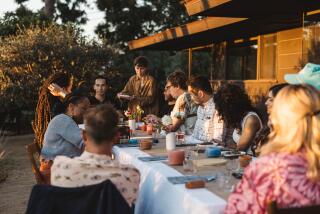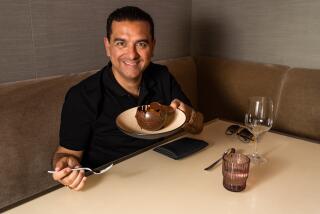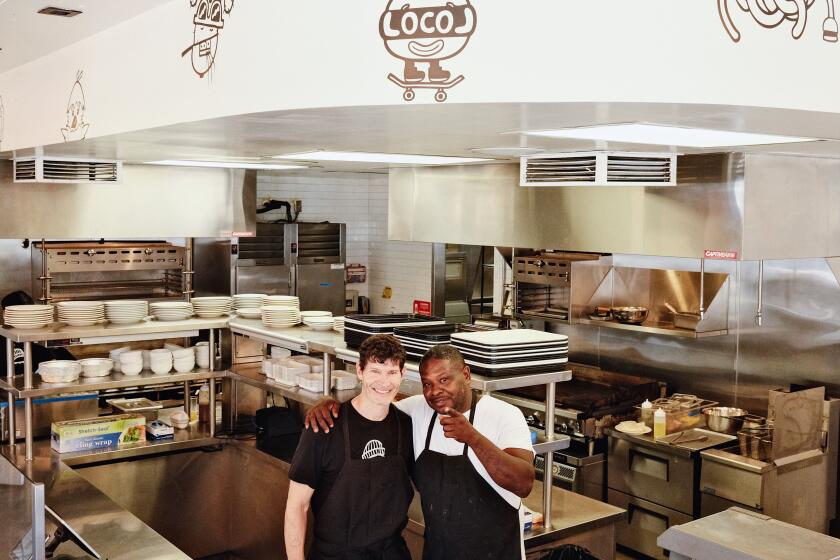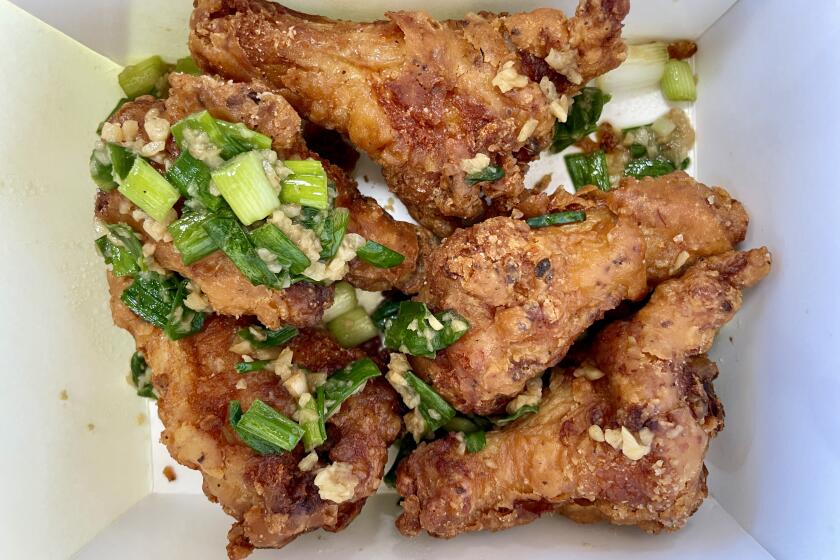The Kitchen Ambassador : Leilei Nwe Thein shares the culture and cooking of Southern California’s tiny Burmese community.
For a dozen years, Leilei Nwe Thein has lived an ocean apart from the land of her birth, Myanmar.
In some ways, though, she has never left home. Friends acknowledge Thein as an unofficial ambassador of Burmese culture. Burmese artwork and hand-painted lacquer furnishings decorate her home in San Diego. Burmese music plays as she relaxes there. Burmese greens grow in her yard. And in her hands, Burmese food becomes wonderfully delicious.
Thein does such a fine job with ohn-no khaukswe--noodles with coconut sauce--that many of her friends have pestered her for a demonstration.
Well-known in southern Myanmar where coconuts are plentiful, ohn-no khaukswe--khaukswe is the Burmese word for noodles; ohn-no means coconut--has trickled over the border into northern Thailand. There are even some Thai restaurants in Los Angeles that serve the soupy noodle dish, but the flavor is substantially altered from the Burmese original.
As friends crowd around to watch, Thein composes a sauce of yellow split peas, chicken broth, coconut milk and onions. In another pot, she cooks chicken with enough paprika to color it deeply. In a third, she boils dried Chinese noodles.
Thein is relaxed and her movements are graceful as she makes this complicated dish look easy. But then she is an experienced teacher. Before coming here, she taught at the University of Rangoon--biology, not cooking.
Now Thein shows how to turn the ingredients for ohn-no khaukswe into a noodle salad, leh thoke, ladling a bit of the coconut sauce into a bowl of the noodles, adding pieces of chicken and a sprinkling of condiments--hard-boiled egg slices, onion, cilantro, crushed hot chiles, lemon, fish sauce and a mixture of fried chiles, garlic and ginger--tossing everything together with her hand, Burmese-style, rather than with a salad fork and spoon. In Upper Myanmar, where coconuts are expensive, the salad is an alternative to the soupy khaukswe, she explains.
Thein now gives her guests bowls of noodles topped with coconut sauce, leaving the choice and proportion of garnishes up to each individual.
Red wine is served, and it goes surprisingly well with this dish. For dessert, Thein offers a typical Myanmar sweet: lumps of toddy palm sugar. Like most expatriate Burmese, she gets certain ingredients directly from Myanmar, transported by relatives and friends. Burmese tea is one, fermented tea leaves another. Known as lapet, the fermented leaves are mixed with nuts, seeds, beans and spices for the nation’s favorite snack.
Thein entertains constantly. On New Year’s Eve, she put out a nonstop buffet. “Come for lunch. Stay for dinner,” she invited. A ground turkey dish had Indian seasonings; vegetables with shrimp were cooked tender-crisp, Chinese-style. These dishes reflected the primary outside influences on Burmese cuisine.
Characteristically Burmese were eggplant stuffed with dried shrimp, chicken in coconut curry and dried fish, yellow beans and “drumstick” in a thick, spicy sauce. Drumstick is a long, tubular vegetable with a tough skin that conceals tender pulp. When cut in short lengths and cooked, it looks somewhat like okra. Thein gets fresh drumstick from relatives who grow the plant and stores it in her freezer.
At her New Year’s Eve event, Thein worried that a thick black mixture in a small bowl might be too strong for some guests. “Burmese cheese,” she called it. Based on seasoned black bean paste from Bagan in Upper Myanmar, it did indeed taste oddly, and not unpleasantly, like super-strong cheese.
After this feast, Thein brought out platters of Burmese sweets, bowls of lapet and pots of Burmese tea. She wore Burmese dress, a longyi (sarong) topped with a blouse and a lacy white vest handmade in Yangon (formerly Rangoon).
Burmese Buddhist monks frequently gather at Thein’s house. Two monks conducted a service before the New Year’s lunch. Eleven took part in a ceremony last July observing the anniversary of the death of Myanmar’s national hero, General Aung San. Assassinated July 19, 1947 at age 32, Aung San led the Burmese in negotiating independence from England and founded a Burmese army.
In Myanmar, July 19 is a national holiday. In Thein’s home, it is a day of great reverence because she is married to Aung San’s son, Aung San U (the U, which is pronounced oo, indicates eldest son). Educated in England, Aung San U moved to the United States in 1973 and met Thein at a New Year’s Eve party in Newport Beach. The portrait of his father that hangs in their living room shows a handsome man in military uniform. (Another of the general’s children is Nobel Peace Prize winner Aung San Suu Kyi, who was released from six years of house arrest last summer.)
For the July ceremony, Thein prepared a 10-course lunch, including vegetarian dishes for those monks who do not eat meat.
Thein, manager of environmental health and safety at the University of San Diego, is often called upon to model Burmese costume, supply exhibits and speak at local cultural events. On Aug. 17, she will take part in an afternoon of Burmese food, fashion and crafts open to the public at the Pacific Asia Museum in Pasadena. Thein has served two terms as chairman of the museum’s Myanmar committee.
In addition to these activities, Thein cultivates a garden that includes the sour Burmese leaf called chin baung; pennywort, which is another green popular in Myanmar; six types of basil; cilantro; lemon grass; Asian eggplants; drumstick; mint; peppers and a banana tree. Once a year, she roasts spices and grinds her own blend of curry powder.
“Burmese food,” Thein says, “is very different from other Southeast Asian food.” Although Thailand is next-door, the two countries season their dishes differently. “We don’t use that much basil; we don’t use that much chile and we never use sugar in our cooking.”
Spicing is lighter than in neighboring India. Unlike the Chinese, the Burmese eat lots of raw vegetables, which they incorporate into salads, and do not season heavily with soy sauce. Although there are few opportunities to taste Burmese food in the United States, Thein reports that Americans who try it--at least the ones who try her cooking--love it.
OHN-NO KHAUKSWE (Burmese Coconut Noodles)
SAUCE AND NOODLES
1/2 pound yellow split peas
Water
1 tablespoon oil
1/2 teaspoon turmeric
1 onion, cut in chunks
1 teaspoon paprika
1 (14 1/2-ounce) can chicken broth
Fish sauce
1 (13 1/2-ounce) can coconut milk
Soak split peas in water to cover several hours or overnight.
Next day, drain peas and rinse twice. Place peas in food processor and add water to cover. Process until ground fine.
Heat oil in Dutch oven. Add turmeric, then onion and saute until tender but not browned. Stir in paprika. Add pea mixture and 2 cups water, rinsing out processor with some of water. Bring to boil over high heat. Reduce heat and simmer until peas start to stick to pot.
Add chicken broth, stir and bring to boil. Add 1 tablespoon fish sauce or to taste and 1 cup water. Shake coconut milk can thoroughly. Add milk and 1 milk can water to pot. Continue to simmer until mixture is heated through and peas are fully cooked.
KHAUKSWE CHICKEN
1 3/4 pounds boneless skinless chicken breasts, cut in bite-size pieces
1 teaspoon salt
1 onion, cut in chunks
1/2 inch ginger root
2 1/2 tablespoons oil
1/4 teaspoon turmeric
3 tablespoons paprika
1/4 cup water
1 pound dried fine Chinese wheat flour noodles
Ground dried hot chiles
Sliced onion
Sliced hard-boiled egg
Cilantro leaves
Lemon wedges
Mix chicken with salt and marinate in refrigerator until ready to cook.
Grind onion and ginger root together in food processor until minced.
Heat oil in Dutch oven. Add onion mixture and saute. Stir in turmeric. Add 1 tablespoon paprika and continue to cook until mixture browns slightly. Add marinated chicken and stir. Add water and remaining 2 tablespoons paprika. Bring to boil, reduce heat and simmer, covered, until chicken is tender, about 15 minutes. Makes 3 1/2 cups.
Cook noodles separately in boiling water until tender, about 10 minutes. Toast ground dried hot chiles in dry cast-iron skillet or griddle over medium-high heat just until fragrant.
To serve, spoon some of noodles into each of 6 large soup bowls. Ladle Sauce over noodles. Place Khaukswe Chicken, sliced onion, egg, cilantro, toasted chiles, lemon wedges and fish sauce in separate bowls to pass with soup bowls. Add few pieces chicken and condiments as desired to noodles.
Makes 6 servings.
Each serving, without garnishes, contains about:
755 calories; 985 mg sodium; 58 mg cholesterol; 25 grams fat; 91 grams carbohydrates; 45 grams protein; 6.73 grams fiber.
LEH THOKE (Burmese Noodle Salad)
“Leh” means hand, and “thoke” means mixed together. Together, they indicate that the dish has been mixed with the hand, not a stirring implement.
2 tablespoons oil
1/2 medium onion, sliced fine
3 to 4 cloves garlic, sliced thin
6 ounces dried fine Chinese wheat flour noodles
1 1/2 tablespoons toasted yellow bean flour (besan)
1 1/2 tablespoons fine-ground dried shrimp
2 teaspoons fish sauce
1/2 teaspoon lemon juice or tamarind liquid
Dash ground toasted hot dried chiles
1/4 onion, sliced
1/4 cup cilantro leaves
Khaukswe Chicken or any leftover chicken, optional
1/4 cup Ohn-no Khaukswe Sauce
Heat oil in small skillet or saucepan. Add 1/2 of onion slices and garlic slices and fry slowly until golden brown. Drain on paper towel. Reserve oil.
Cook noodles in boiling water until tender, about 10 minutes. Drain, place in bowl and cool to room temperature.
To assemble salad, add bean flour, ground shrimp, fish sauce, lemon juice and dried chiles to noodles. Top with remaining sliced onion, cilantro, reserved fried onion-garlic mixture and few pieces chicken. Toss to mix. Moisten with Ohn-no Khaukswe sauce, including any oil that may float on surface. If sauce is not available, moisten with oil from frying onion and garlic.
Makes 4 servings.
Each serving contains about:
250 calories; 257 mg sodium; 6 mg cholesterol; 8 grams fat; 38 grams carbohydrates; 7 grams protein; 2.10 grams fiber.
LEILEI’S CHICKEN SALAD
1 small and 1/4 medium onion
9 to 10 cloves garlic
2 tablespoons oil
2 pounds boneless skinless chicken breasts, cut in strips
1 cup fresh basil leaves
1 cup cilantro leaves
2 teaspoons roasted yellow bean powder (besan)
2 tablespoons lime juice
2 tablespoons fish sauce
Cut 1/4 onion in fine slices. Cut 3 to 4 cloves garlic into thin slices. Heat oil in small skillet or saucepan over medium-high heat and add sliced onion and garlic. Fry until crisp. Set aside.
Simmer chicken strips in salted water to cover until cooked through, 10 to 15 minutes, depending upon thickness of strips. Drain and place in salad bowl.
Cut remaining small onion in strips. Cut remaining 6 cloves garlic in thin slices.
Add onion and garlic slices, basil leaves, cilantro leaves, bean powder, lime juice, fish sauce and fried onion-garlic mixture to salad bowl. Toss to mix.
Makes 4 to 6 servings.
Each of 6 servings contains about:
286 calories; 453 mg sodium; 99 mg cholesterol; 10 grams fat; 8 grams carbohydrates; 41 grams protein; 0.64 gram fiber.
More to Read
Eat your way across L.A.
Get our weekly Tasting Notes newsletter for reviews, news and more.
You may occasionally receive promotional content from the Los Angeles Times.






